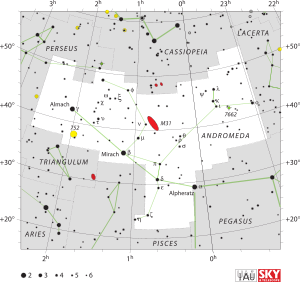Iota Andromedae
Iota Andromedae is a single[11] star in the northern constellation of Andromeda. It has the Flamsteed designation 17 Andromedae, while Iota Andromedae is the Bayer designation as Latinized from ι Andromedae. This object is visible to the naked eye at night as a faint, blue-white hued star with an apparent visual magnitude of +4.29.[2] Based upon parallax measurements, it is located approximately 500 light years distant from the Sun.[1]
 | |
| Observation data Epoch J2000 Equinox J2000 | |
|---|---|
| Constellation | Andromeda |
| Right ascension | 23h 38m 08.20130s[1] |
| Declination | +43° 16′ 05.0649″[1] |
| Apparent magnitude (V) | +4.29[2] |
| Characteristics | |
| Evolutionary stage | main sequence |
| Spectral type | B8 V[3][4] |
| U−B color index | –0.29[5] |
| B−V color index | –0.11[5] |
| Variable type | constant[6] |
| Astrometry | |
| Radial velocity (Rv) | –0.5[2] km/s |
| Proper motion (μ) | RA: +27.64[1] mas/yr Dec.: -1.02[1] mas/yr |
| Parallax (π) | 6.53 ± 0.16[1] mas |
| Distance | 500 ± 10 ly (153 ± 4 pc) |
| Absolute magnitude (MV) | −1.63[7] |
| Details | |
| Mass | 3.1[4] M☉ |
| Luminosity | 638[7] L☉ |
| Surface gravity (log g) | 3.35[6] cgs |
| Temperature | 12,620[8] K |
| Metallicity [Fe/H] | −0.19±0.14[6] dex |
| Rotational velocity (v sin i) | 70[9] km/s |
| Age | 116[4] Myr |
| Other designations | |
| Database references | |
| SIMBAD | data |
This object is a B-type main-sequence star with a stellar classification of B8 V. It is among the least variable stars observed during the Hipparcos mission.[6] The star is 116[4] million years old with 3.1[4] times the mass of the Sun and is spinning with a projected rotational velocity of 70 km/s.[9] It is radiating 638[7] times the luminosity of the Sun from its photosphere at an effective temperature of 12,620 K.[8] Iota Andromedae is a debris disk candidate, showing an infrared excess at a wavelength of 18 µm.[12]
Name
In the catalogue of stars in the Calendarium of Al Achsasi Al Mouakket, this star was designated Keff al-Salsalat (كف المسلسلة - kaf al-musalsala), which was translated into Latin as Manus Catenata, meaning palm of chained woman.[13]
In Chinese, 螣蛇 (Téng Shé), meaning Flying Serpent, refers to an asterism consisting of ι Andromedae, α Lacertae, 4 Lacertae, π2 Cygni, π1 Cygni, HD 206267, ε Cephei, β Lacertae, σ Cassiopeiae, ρ Cassiopeiae, τ Cassiopeiae, AR Cassiopeiae, 9 Lacertae, 3 Andromedae, 7 Andromedae, 8 Andromedae, λ Andromedae, κ Andromedae and ψ Andromedae. Consequently, the Chinese name for ι Andromedae itself is 螣蛇二十二 (Téng Shé èrshíèr, English: the Twenty Second Star of Flying Serpent).[14]
References
- van Leeuwen, F. (November 2007), "Validation of the new Hipparcos reduction", Astronomy and Astrophysics, 474 (2): 653–664, arXiv:0708.1752, Bibcode:2007A&A...474..653V, doi:10.1051/0004-6361:20078357
- Wielen, R.; et al. (1999), Sixth Catalogue of Fundamental Stars (FK6). Part I. Basic fundamental stars with direct solutions, Astronomisches Rechen-Institut Heidelberg, Bibcode:1999VeARI..35....1W.
- Crawford, David L. (September 1958), "Two-Dimensional Spectral Classification by Narrow-Band Photometry for B Stats in Clusters and Associations", Astrophysical Journal, 128: 185, Bibcode:1958ApJ...128..185C, doi:10.1086/146536.
- Gullikson, Kevin; et al. (2016), "The Close Companion Mass-ratio Distribution of Intermediate-mass Stars", The Astronomical Journal, 152 (2): 40, arXiv:1604.06456, Bibcode:2016AJ....152...40G.
- Johnson, H. L.; et al. (1966), "UBVRIJKL photometry of the bright stars", Communications of the Lunar and Planetary Laboratory, 4 (99), Bibcode:1966CoLPL...4...99J
- Kocer, D.; et al. (August 2003), "Elemental abundance analyses with DAO spectrograms. XXVII. The superficially normal stars theta And (A2 IV), epsilon Del (B6 III), epsilon Aqr (A1.5 V), and iota And (B9 V)", Astronomy and Astrophysics, 406: 975–980, Bibcode:2003A&A...406..975K, doi:10.1051/0004-6361:20030620
- Anderson, E.; Francis, Ch. (2012), "XHIP: An extended hipparcos compilation", Astronomy Letters, 38 (5): 331, arXiv:1108.4971, Bibcode:2012AstL...38..331A, doi:10.1134/S1063773712050015.
- Zorec, J.; et al. (July 2009), "Fundamental parameters of B supergiants from the BCD system. I. Calibration of the (λ_1, D) parameters into Teff", Astronomy and Astrophysics, 501 (1): 297–320, arXiv:0903.5134, Bibcode:2009A&A...501..297Z, doi:10.1051/0004-6361/200811147
- Abt, Helmut A.; Levato, Hugo; Grosso, Monica (July 2002), "Rotational Velocities of B Stars", The Astrophysical Journal, 573 (1): 359–365, Bibcode:2002ApJ...573..359A, doi:10.1086/340590
- "iot And -- Star", SIMBAD Astronomical Object Database, Centre de Données astronomiques de Strasbourg, retrieved 2012-06-19
- Eggleton, P. P.; Tokovinin, A. A. (September 2008), "A catalogue of multiplicity among bright stellar systems", Monthly Notices of the Royal Astronomical Society, 389 (2): 869–879, arXiv:0806.2878, Bibcode:2008MNRAS.389..869E, doi:10.1111/j.1365-2966.2008.13596.x.
- Ishihara, Daisuke; et al. (May 2017), "Faint warm debris disks around nearby bright stars explored by AKARI and IRSF", Astronomy & Astrophysics, 601: 18, arXiv:1608.04480, Bibcode:2017A&A...601A..72I, doi:10.1051/0004-6361/201526215, A72.
- Knobel, E. B. (June 1895). "Al Achsasi Al Mouakket, on a catalogue of stars in the Calendarium of Mohammad Al Achsasi Al Mouakket". Monthly Notices of the Royal Astronomical Society. 55: 429. Bibcode:1895MNRAS..55..429K. doi:10.1093/mnras/55.8.429.
- (in Chinese) AEEA (Activities of Exhibition and Education in Astronomy) 天文教育資訊網 2006 年 7 月 7 日